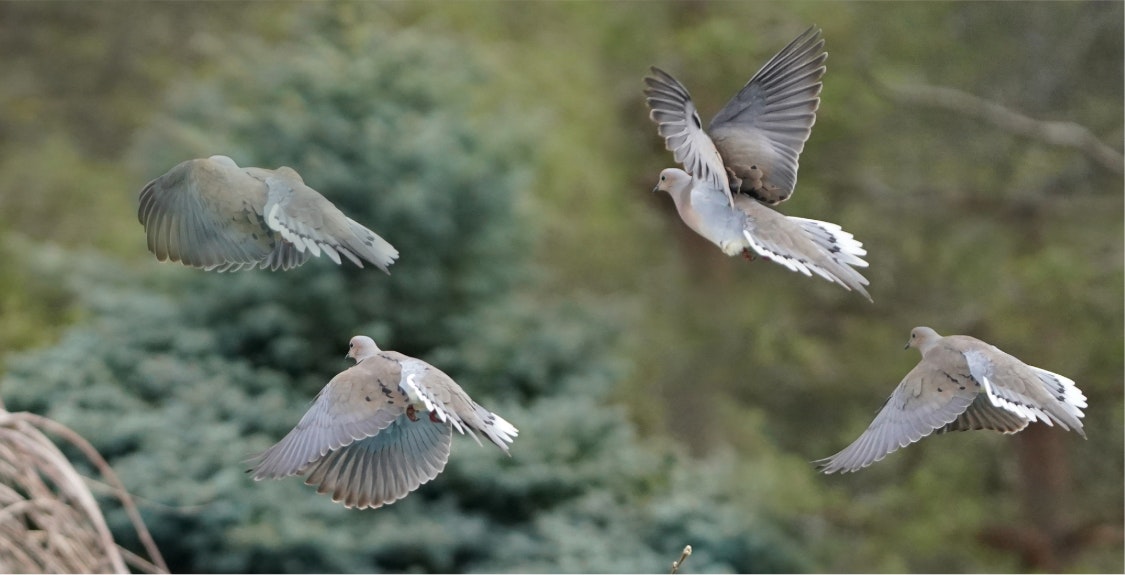AFM NEWS
How to Develop a Productive Dove Field for Hunting Season

With dove hunting season approaching, it's time to ensure that your dove fields are optimized. Even if you've missed the window for planting season, bookmark this tab for planning ahead next year. Shane Fuller, one of AFM's Certified Wildlife Biologists, weighs in on all the necessary components of a well-executed dove field, from planted crops, field size, and configuration.
First, it's important to know some facts about the mourning dove to better understand what is suitable for your field. Mourning doves are the most abundant and widespread gamebird in North America, but despite millions of birds being harvested, the U.S. population is estimated in the 300 millions. While quails and pheasants scratch the ground to forage for food, the mourning dove has relatively weak legs and feet. As such, they need bare ground or areas with thinner ground cover so they can see seeds lying on the ground. Since doves seek food on the ground, one item for reconsideration is the use of lead pellets. It is estimated that 1 in 20 doves may eat lead pellets, thus exposing them to lead poisoning. Hunters may wish to use alternative pellets made of tin, zinc, or copper to ensure that the mourning dove population remains stable. Additionally, landowners should review state and federal regulations regarding baiting to ensure compliance. What's considered legal planting versus illegal baiting can vary by location and activity, so it's important to review federal/state guidelines to avoid violations during dove season.
Field Size and Configuration
Before digging in and planting, determine the size and configuration of your dove field. While one acre located in an ideal area can attract doves, two acres is considered a minimum for dove fields. Ten to twenty acres are considered optimal, as this can attract a significant number of doves and provide adequate space for hunter participation. Larger fields can also supply doves with a reliable food source for a longer period of time, especially when crops are planted at staggered times and germinate at different rates.
The configuration of the field is just as pertinent as the amount of space allocated. Generally, long, rectangular fields are desired, as doves prefer wide open spaces. Orienting the fields from North to South ensures optimal hunting for morning and evening participants due to the sun's position. Additionally, doves like to use trees for roosting and loafing.
Once the size and configuration have been decided, it's time to plan crop types and layout. A thoughtful combination of layout and planting strategy will help ensure your field attracts doves and supports safe, enjoyable hunts.
Crops: Logistics, Types, and Planting Techniques
Landowners should plan for warm-season plantings twice yearly; first during April 1- May 2, and then again June 1-July 15 (depending on the crops planted). Plants will mature at different times throughout the summer, contributing to a constant food source and a greater number of birds when hunting season opens (double-check your specific location for the start of the season).
There are several layouts for landowners to consider on their dove fields, and each has its own benefits. Strips and blocks are used to manage food and accommodate hunters, as strips alternate between food and open areas, creating feeding and shooting lanes. Landowners could utilize a patchwork design, allowing for different crops to be planted and attracting a variety of seed-eating birds in addition to doves. Cover rows (typically tall plants like corn, sunflowers, and grain sorghum) provide cover and concealment for hunters. If this option is selected or used in conjunction with other layouts, it's vital to hunter safety to space the rows apart.
After determining the layout, it's essential to prepare the field for planting. Many landowners choose to disk or till the soil, and some choose to apply herbicides to keep the weeds at bay. Seeds can be planted by broadcasting or drilling. In terms of crop types, numerous agricultural plantings are appealing to doves, including soybeans, sunflowers, wheat, browntop millet, grain sorghum, corn, peanuts, and more. Ragweed, pokeweed, dove croton, and foxtail grass are other common plants, although wheat, millet, corn, sunflowers, and dove proso are some of the best options for attracting doves. Regardless of the crop type, they should be planted in strips ranging from 30-90 feet wide. General maintenance includes mowing, disking, or burning the strips at alternate times, allowing doves to feed more easily during hunting season. Beyond crop selection and upkeep, there are a few additional elements that can elevate the appeal of your dove field even further.
Other considerations for your dove field are grit and water features. Grit helps to maintain bare soil, and it assists doves in processing the seeds as well. Water features, like a pond or trough, can increase dove use during those hot summer days. Proximity to small power lines is also a plus, as doves can often be seen perching on the lines.
Next Steps: Get Ready for a Successful Season
A productive dove field doesn't happen by chance. It's the result of planning, preparation, and well-timed planting. From selecting the right crops to designing a smart layout, these steps can turn your property into a prime hunting destination. Whether you're looking to attract more doves or ensure safety and success during the season, our Wildlife Services team is here to help. Reach out today to collaborate with our Certified Wildlife Biologists and make the most of your dove field this season.

